Meet the golf course manager: Dan Harding
Related Articles
The course manager at Old Thorns in Hampshire talks about maintaining a venue designed for 7,000 rounds a year but has 35,000 and the extensive bunker renovation project his team undertook.
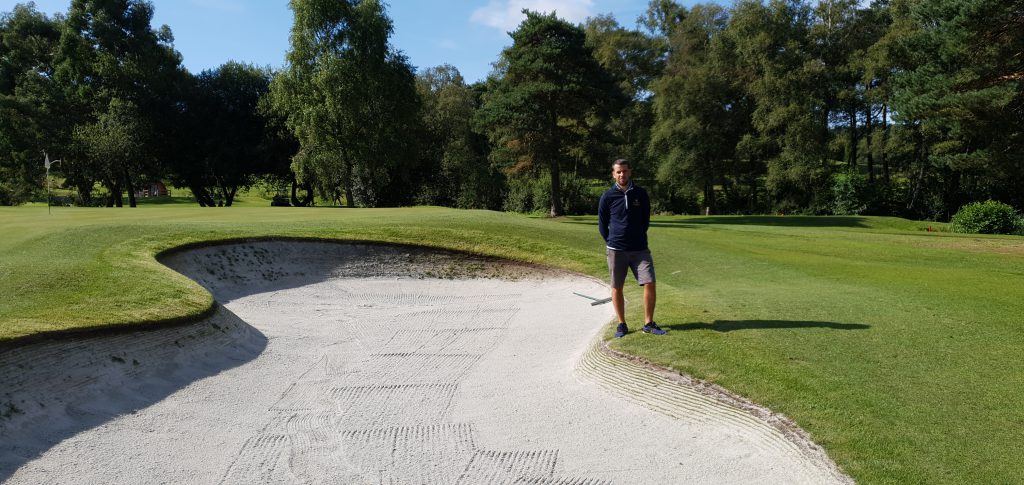
Officially opened in 1982 by Jack Nicklaus, Seve Ballesteros, Isao Aoki and Bill Roger, and set in the rolling hills of Hampshire, Old Thorns is a true test of golf for all levels of golfer. Designed by the club president and ‘voice of golf’ Peter Alliss, the course, which offers spectacular views across South Downs National Park, has small undulating greens, tricky bunkers, strategically placed ponds and will only reward the most accurate of shots.
We caught up with Dan Harding, course manager at Old Thorns, to find out about him – and the work that goes into maintaining a venue that is connected to some of the biggest names in golf.

What was your path to greenkeeping, where did you study and how long have you now been at Old Thorns Hotel, Golf and Spa Resort?
I first fell into greenkeeping on a work experience placement at Old Thorns when I was 14. The course manager at the time, Derek Cunliffe, offered me a summer job, which I took. That then led into a full-time job when I left school, it was then that I completed my level 2 in sports turf at Sparsholt College. I left Old Thorns for a summer placement at Kauri Cliffs in New Zealand, which was ranked in the top 60 in the world at the time, after this amazing experience I came home to work at Blackmoor Golf club.
It was at Blackmoor that I completed my level 3, again through Sparsholt College. It was at Blackmoor under James Norris that I found my passion for heathland golf courses. After six years at Blackmoor I moved onto Hankley Common, another top heathland course working under Gareth Roberts.
I moved back to Old Thorns as course manager in 2015 where I am currently studying my HNC in sports turf management through Elmwood, it was through this course that I was able to become an R&A scholar.
I have been very lucky in my time to work under some great course managers who have all helped shape me into the greenkeeper I am now. Becoming an R&A scholar was a great achievement and has opened many doors and experiences, one of these was the opportunity to travel to Askernish Golf club with some great people who I still stay in contact with now.

The resort seems quite extensive, what exactly do you and your team have to maintain?
The resort is very large; my team and I are responsible for the 18-hole golf course, all hotel grounds which include flower beds, all lawn areas, staff houses and a tennis court, and our mechanic looks after horse paddocks one day a week. My team and I also have common land that needs to be checked regularly and all fences maintained. The company also own another nearby hotel which we have often had to send a team of greenkeepers over to help with all the maintenance of the grounds.

What is the size of your team and how do you maximise the resources to ensure a high-end product is delivered to members and visitors?
We try to run with eight full-time staff members which includes myself and a mechanic; we add two causal staff in the summer. I have my deputy, Ryan, who helps keep things ticking over and who I can happily leave when I’m not there. Andy is our first assistant, who has worked his way up to the position he is now. Pete is our mechanic who we seem to keep very busy all the time and the rest of the team is Lee, Rob, Stuart and Rob. The team is filled with a good variety of youth and experience and finally we have our trusted casual, Ollie, who has been with us for three summers now.

Albeit the course is small, the presentation is very high. How many rounds was it designed for originally and how many are currently being played, and what are the challenges you and the team face in maintaining such a top drawer course?
The course was originally designed for around 7,000 rounds and now we have upwards of 35,000 rounds. One of the main challenges is that we are a resort golf course with a small membership – this mean that every visitor and society we have expect the course to be in the best condition possible for their day at our venue. The team works really hard to ensure this happens.
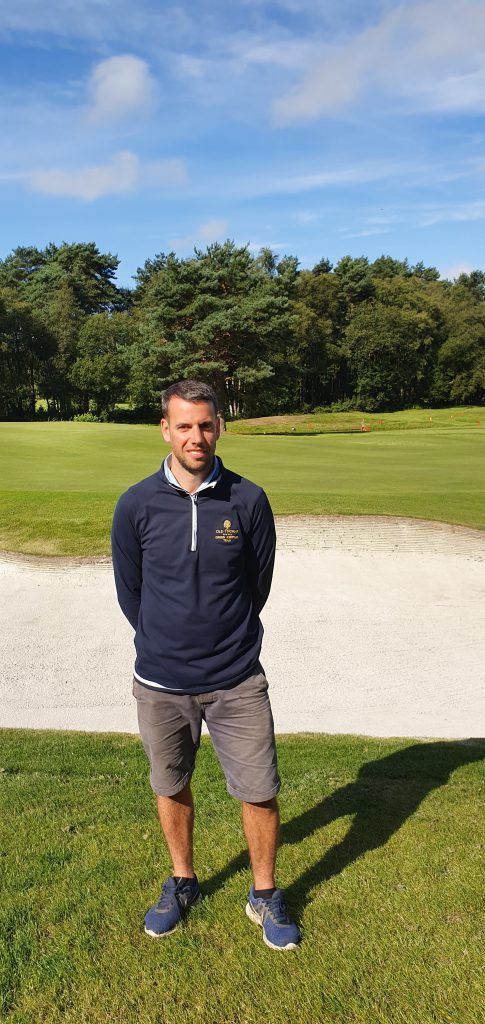
Drainage can be an issue during the winter months. Which parts of the course does this effect most adversely, how do you remedy the problems and do you have any plans to install more drainage systems?
A lot of our holes sit on clay, which can sit wet in the winter months. We had drains installed around 15 years ago that are still working today. It is very important to clear these and ensure all outlets and ditches are clear.
At the start of the winter we will clear all ditches out with a digger and usually walk through them monthly after to keep them clear. We had secondary drainage put in a few years after the primary was installed. We currently don’t have plans to introduce more drainage to the fairways and are concentrating on reducing thatch, more aeration and other methods to help the water through into the drains. All my team are now very experienced in fixing any problem that may arise through the winter months.
We have also had the PC drainage installed in one of our greens and have had very good results in this and is something I would like to install into other greens.
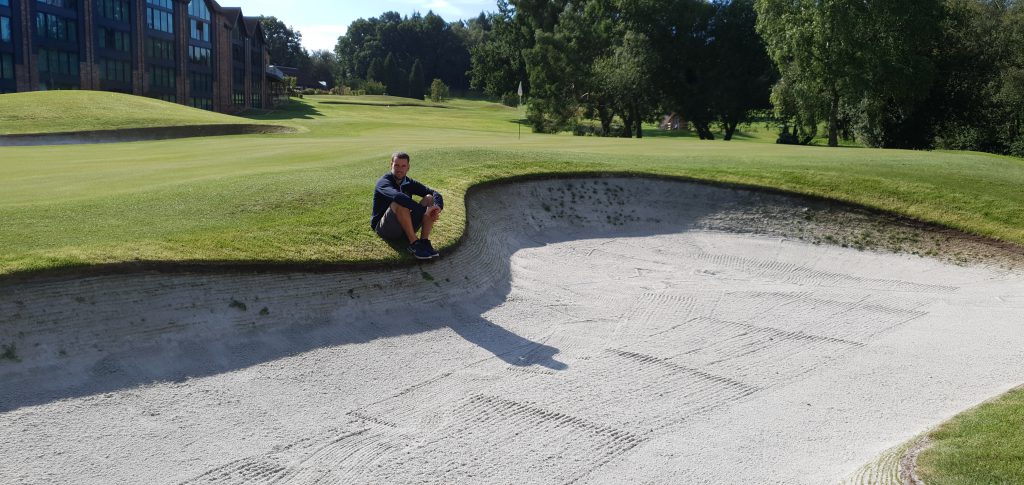
What aeration programme do you run and what machinery do you use?
We run a monthly programme though the year on the greens, we book two days a month into the tee sheet and delay the tee times in the morning to give us a little extra time to get ahead.
On these days through the golf season we will tine the greens using the ProCore at different depths and top-dress over the top; during the winter months we run the Verti-Drain over the greens to get that little bit deeper with the tines to help the water movement through the profile. We have two maintenance weeks, one at the end of February and one at the start of August. We usually core the greens at this time, the last two years we have used the Graden CSI as well as coring in August to help reduce some of the thatch build up that was in the greens when I started. We also core tees and approaches in August. Throughout the winter we will solid tine the fairways using the Verti-Drain and use the Verti-Quake to help relieve compaction.
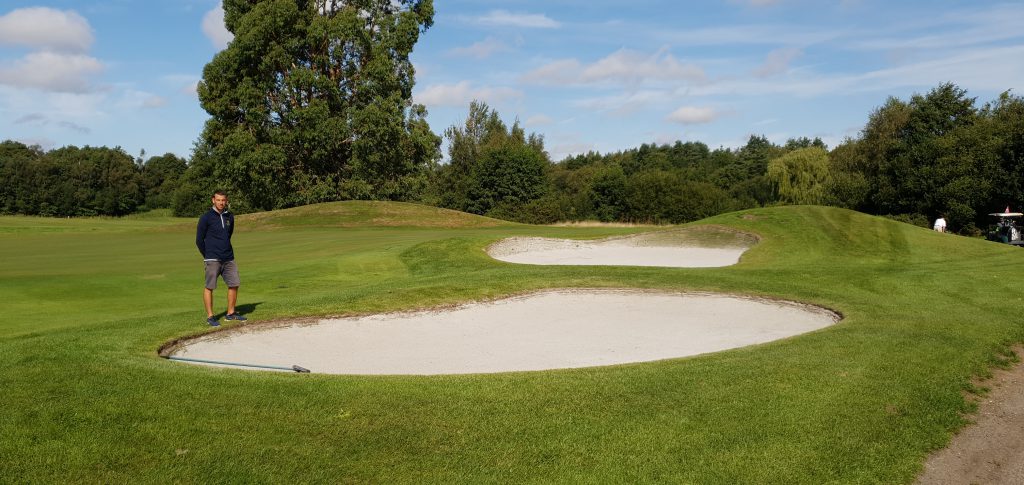
A number of chemical products have been removed from the market, lessening the armoury of the greenkeeper. How much of a challenge are you finding this now presents?
Yes, it is becoming an interesting time for greenkeepers and we are all having to adapt, and some have already done this. We are concentrating on plant health, dew cures to keep moisture off the plant, aeration, higher height of cut, sharper units for a clean cut, just trying to create the best possible environment for the plant and reduce the stress we are placing on the plant.
The preventive options we have are very good but, in the south, these can only last two weeks if the conditions are right and this is a huge challenge. With the environment we sit in it can be a breading ground for Microdochium Patch at time with the little air movement within the trees. Companies like ICL, Syngenta and Rigby Taylor are doing great trials in this with interesting results so that data could help us.
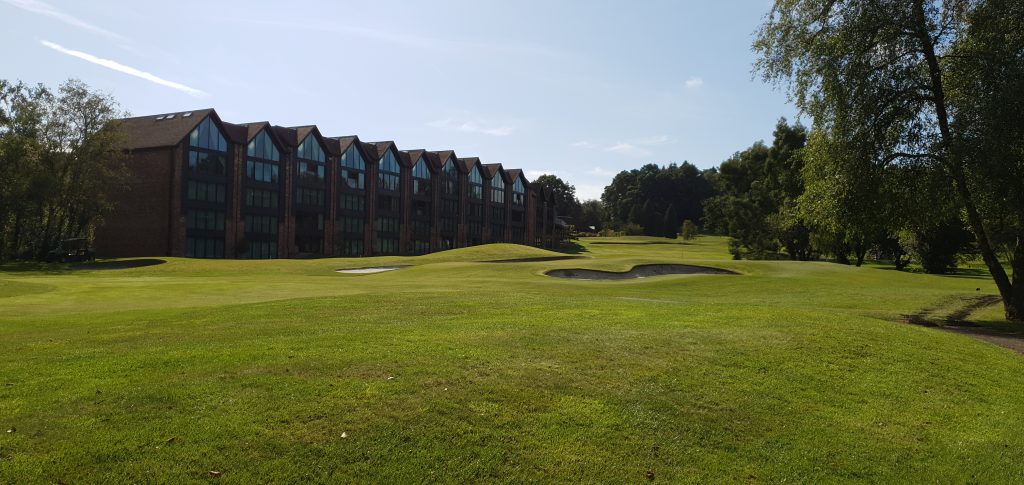
What irrigation system are you currently using and how is it set up across the course?
We have the Toro 760 series electric valve in heads around the greens and approaches, we are replacing these with the Toro 835 series electric valve in heads when we need to, which run off the Bailoy system.
Our water is pulled from a large lake on our eighth hole, most of the ditches on the course feed this lake so we are making the most of any rainwater that falls.
We have a service contract with Topturf irrigation, who look after the system for us. We have a good relationship with them, Rob and his team are brilliant and will always be on site when needed.
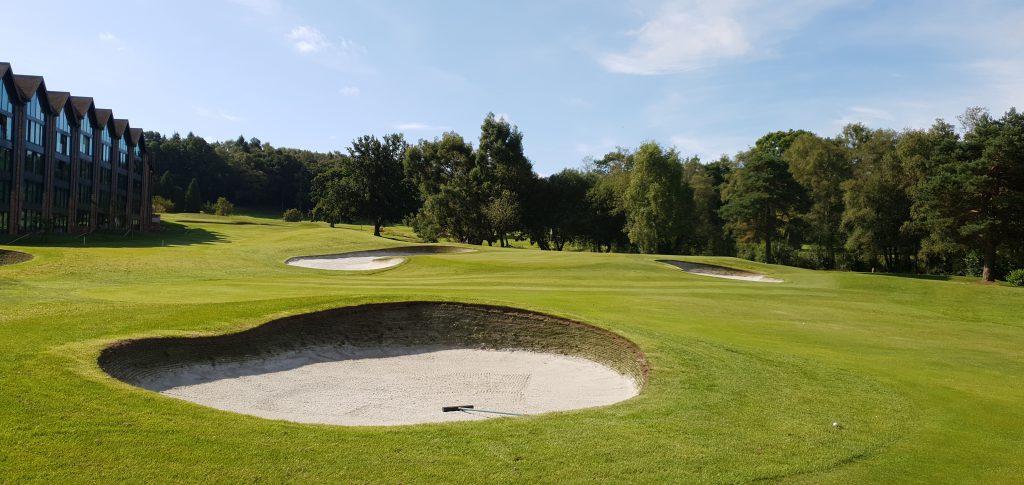
Old Thorns GC has been undertaking a bunker renovation programme. What were the problems you faced and reasons for the renovation and how did you go about evaluating available products in the market and why did you select Ecobunker?
We were finding that more and more golfers were showing a lack of respect for the course and would walk out of bunkers at the closest point, whether it be the face of the bunker or not, this was starting to collapse some of the bunker edges.
The bunkers had also been edged back over the years by pervious greenkeepers trying to maintain a clean edge and were beginning to become large irregular shapes.
Drainage was also starting to become an issue in some of them; a new bunker project was a necessity. I had seen EcoBunker in magazines and knew Andy at Royal Winchester had done some so phoned him for his thoughts.
I thought it would work at our course, we trialled one bunker and had great feedback form members and visitors.

How many bunkers do you have in total, how easy have you found them to install, how many have you completed to date, what liners and sand are you using and over what timeframe do you expect to build the remaining bunkers?
We have 47 bunkers in total. We have found a formula that works well for us now after two winters of trying different methods.
The new construction method is working well for us. EcoBunker have been helpful and often pop in if they are in the area to see how we are getting on and to offer up any new ideas.
The team here are getting very good at this now as we have completed 23 bunkers, the EcoBunker wall on an average size bunker can be built within two days. We use a liner, also from Ecobunker, that comes rolled up. It is a rubber liner that we must cut to shape, tape and glue the joins and peg down.
This is a very good product for the budget that was available to me. We are using Hedon sand which is a slight grey colour and again have had good feedback.
We are hoping to have the greenside done within the next two years and then move onto the fairway bunkers, but this plan could change still.
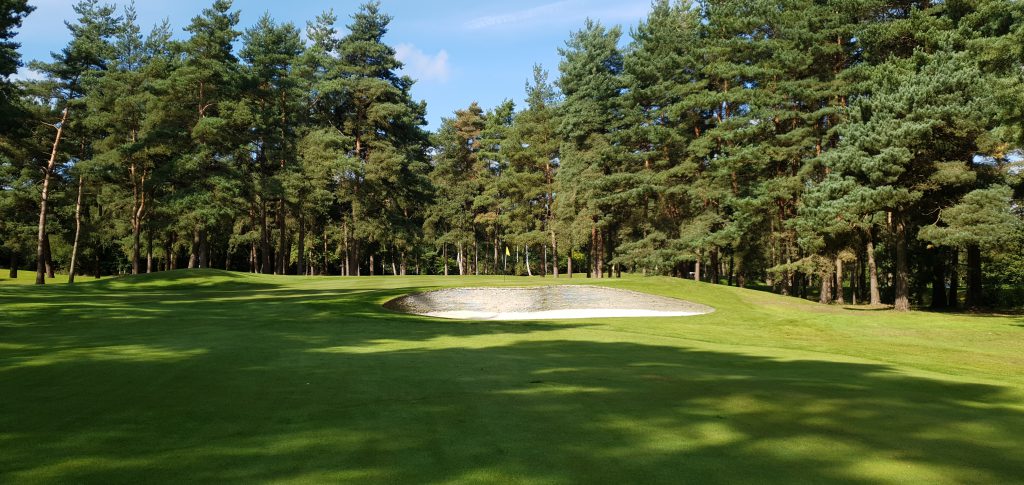
How have the new bunkers been received by golfers and what reduction have you seen in bunker wash out and general maintenance. Would you recommend Ecobunker?
The new bunkers have gone down well, as I said we are now into our third year of building these and the latest ones have gone down the best.
We have made a few subtle changes each year and now feel we have it right. As we are installing new drainage and liner we are noticing little wash out and no matter how much rain we have we can fully rake them the next day. The maintenance of them has been reduced dramatically, we are able to Flymo and strim all the bunkers within four hours. Once a month we will brush the faces to brush the sand off.
I would definitely recommend EcoBunker, Richard and his team have been brilliant, from the first meeting with Richard to now, Huw still pops in when he is in the area and EcoBunker support the club by sponsoring holes in our Pro-Am and entering a team in the event.
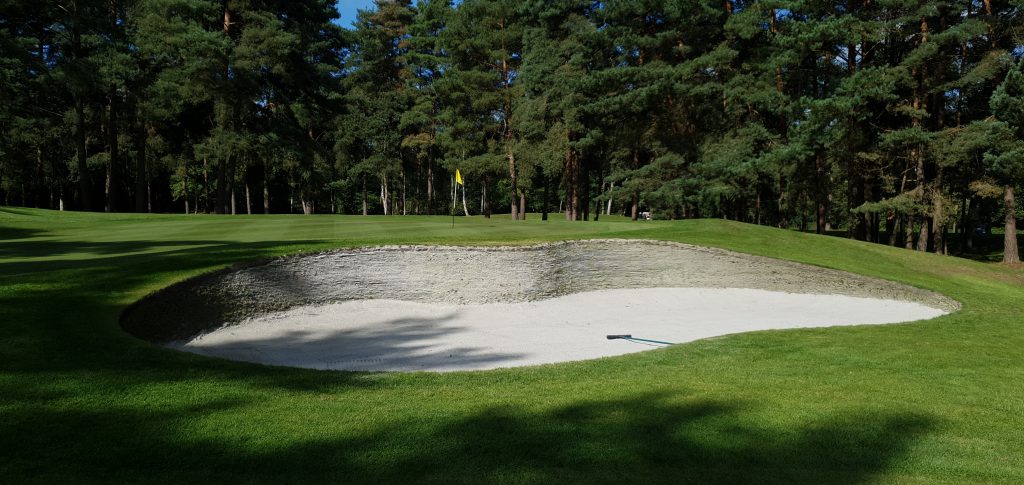
You were recently introduced to a new seed cultivar and are now using it. How did this come about, where are you using it on the course, what results have you seen and who supplies this?
Andy Barber at Royal Winchester kept telling me to try the A5 dwarf rye seed from Germinal on the tees – A5 is a mix of Cabrio and Escapade. I have a lot of time for Andy so I decided to tried it out and have had great results from it, the leaf is so fine, it establishes very quickly and is just what we need at Old Thorns.
Our tees are very small so we have to be very clever with making the most of the space available and need a seed that will establish quick and take the wear it is put under. We are also moving over to Creeping Bent on the greens and using the 007 this August. I know not everyone will agree with this but I also know of greenkeepers who are also doing it, we did overseed some weaker areas on the greens with the dwarf rye.
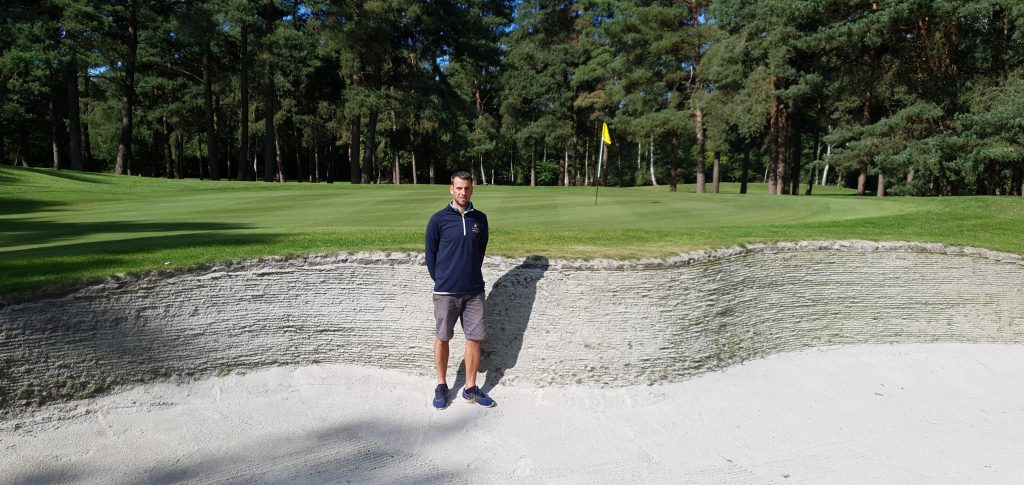
What do you think are the strengths that have carried you through your career and current position at Old Thorns Golf Club and what are your goals for the course?
I’m always wanting to learn more, I don’t think you can stop learning in this industry and have always thought this. I have tried to take as much knowledge and information from my pervious course managers.
One of my strengths I feel is that I have worked hard under all my pervious course managers and that work helped me get the course manager’s job at Old Thorns when they were asked for references. My goals for the course are to continue to improve the course and create the best golf course possible with the resources available.
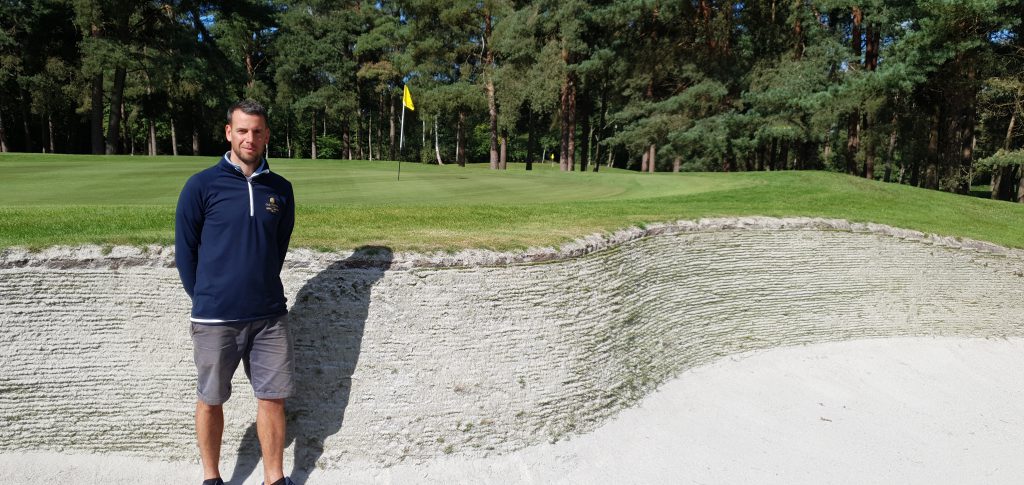
What height of cut do you use across the course?
We took the greens down to 3.25mm for our club championships and pro-am this year but have been running at 3.5mm or 3.75mm depending on conditions, and so on, most of the summer. We have found that hand cutting daily this year has helped maintain a decent speed to them. Tees and approaches are cut to 9mm through the summer and fairways have been at 14mm. All heights of cut will be raised in the winter. Two men can have the greens cut by 10.30am, tees and approaches each take a morning to cut and fairways we allow a day for. We keep the semi at one and a half inches and this takes around a day to cut, rough is two and a half inches and we allow two days to fully cut this.
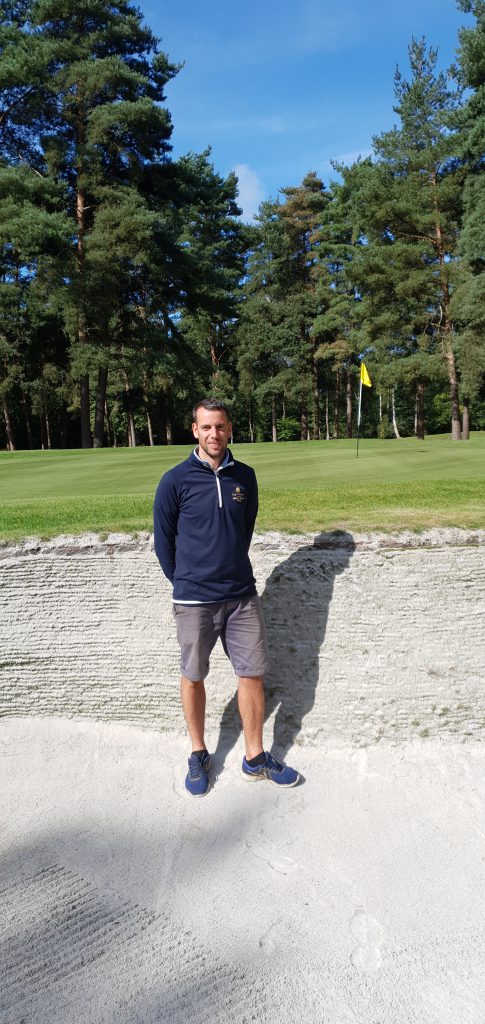
The course has a significant number of trees. How much of an impact do they have on the course, what tree maintenance programme do you run and how often, and are you undertaking this in-house?
It has a huge impact on playing surfaces near the heavily-wooded areas; we are a parkland course with tree-lined holes. It was one of the first jobs I identified when I took over as high priority, only to find there was no felling licence. Once we obtained our licence we started felling trees around the greens that had very little sunlight through the winter months. We still have a long way to go as we are very busy through the winter months with the EcoBunker builds. Our plan is to try to keep the character of each hole while clearing the trees; myself and my deputy will identify trees that we feel need to be felled and trees we think should be kept. All trees are felled in-house, we do have tree surgeons who come in and limb up the pine trees around the greens and tees to help keep the character of holes, but allow light through.
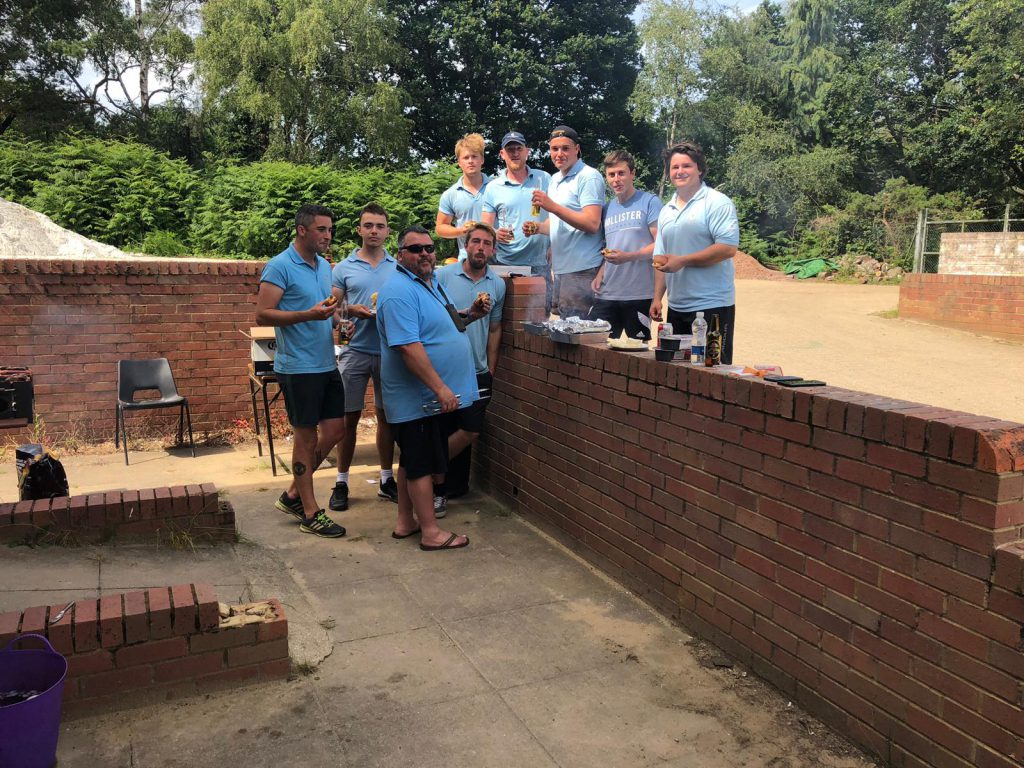
The greenkeeping team at Old Thorns
What current machinery fleet are you using and is there a particular piece that you have a preference for?
We are mainly John Deere with the cutting equipment, tractors and vehicles. We have a ProCore for aeration on greens, tees and approaches. We use a Verti-Drain on all areas of the course, we also have a Verti-Quake for use on the fairways. We also have a Graden CSI and Charterhouse core collector. We use a GreenTek brush and Terra rake on the fairways as well as a Charterhouse overseeder. The Charterhouse equipment is great – the Verti-Drain, Verti-Quake and overseeder have been very useful after last summer’s drought.

The pressures on the course manager to deliver a better product are growing year on year and the level of professionalism is rising with this. What do you think are the qualities now needed to meet the requirements and demands of golfers by someone in your position and how does this help contribute to the business of golf?
There is massive pressure on us now to produce quality golf courses with immaculate playing surfaces all year round – this can be very difficult on a clay-based site. I think you need to have a good plan for the work and maintenance needed to maintain the course to the highest standards but also be very flexible in this as the weather conditions can change this plan.
I believe you also need a good team around you who you trust as you can’t always be everywhere on the golf course to see what is happening. I have a good deputy and team around me to who will always inform me of any issues that may arise.
Communication is also vital to members and visitors. It can be as small as a notice board in the pro shop, a newsletter or an annual report at a members’ AGM, if members and visitors know what and why you are doing things, they will be more understanding.
At Old Thorns the course needs to be in the best condition possible or we need to have justifiable reasons for the customers to be happy, if we don’t this could affect the business and profits.
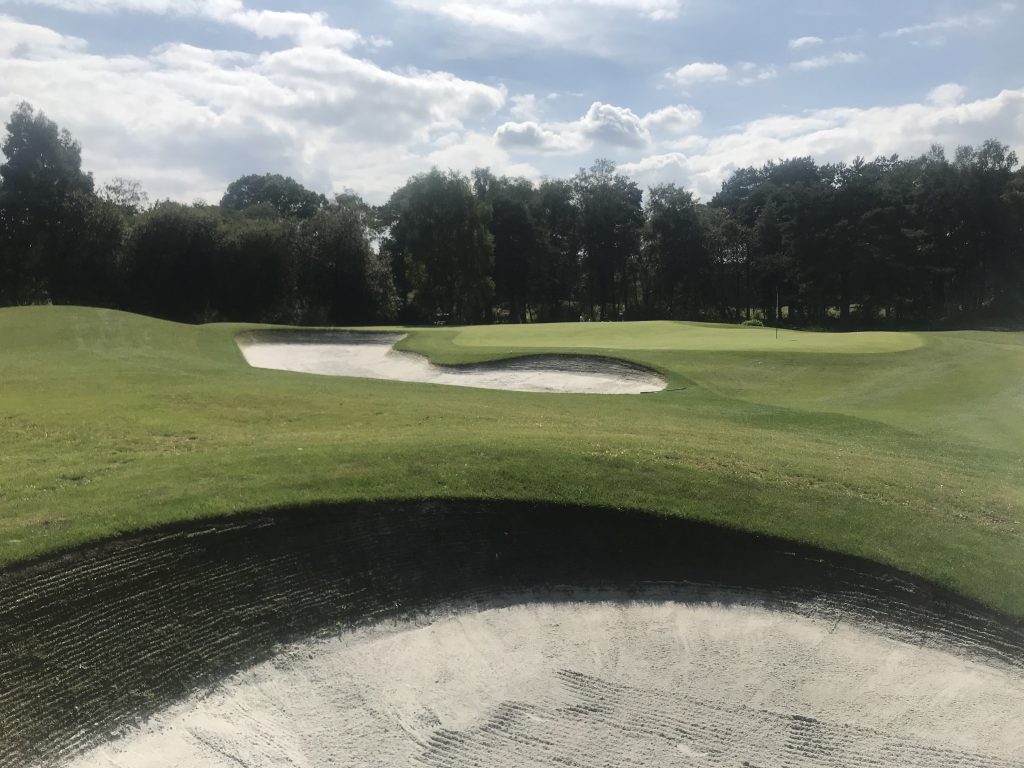
What currently gives you the greatest satisfaction from your job?
Seeing the course in its peak in the summer is always satisfying when everything is striped and cut, bunkers are tidy, ditches and ponds are strimmed and you know the team have worked hard to get it into that shape.
I’m very proud of the work the team do and the effort they all put in and will always defend them if anyone ever questions something they have done.
Also knowing the hard work the team have done during the renovation – and the continuing work the team put in to ensure the course is fully open as much as possible. When I started the course was shut a lot in the winter but now we are reducing that number significantly.
The bunker renovation is obviously another big achievement for the team here and something each of them are proud of being involved with, it is nice driving around looking at the good work the team has done with them.
The biggest achievement is the building of the new ninth green, this was something we completed with Conor Walsh, who is a fantastic shaper and one of the most professional and precise men I have ever worked with. I would recommend Conor to anyone who is looking into construction work at their course. The new green was designed by Peter Alliss, who originally designed the course, this was a good process to be involved with and Peter was always popping down to have a look at the progress of the green. The team all got very involved in this with Conor and were all willing to put in extra hours to help, it was a get experience and learning curve for all involved.
Seeing my staff improve is very satisfying and listening to them talk passionately about the course and come up with ideas. I like to give them a little bit of freedom to express ideas and this is great to see when they come up with ideas.
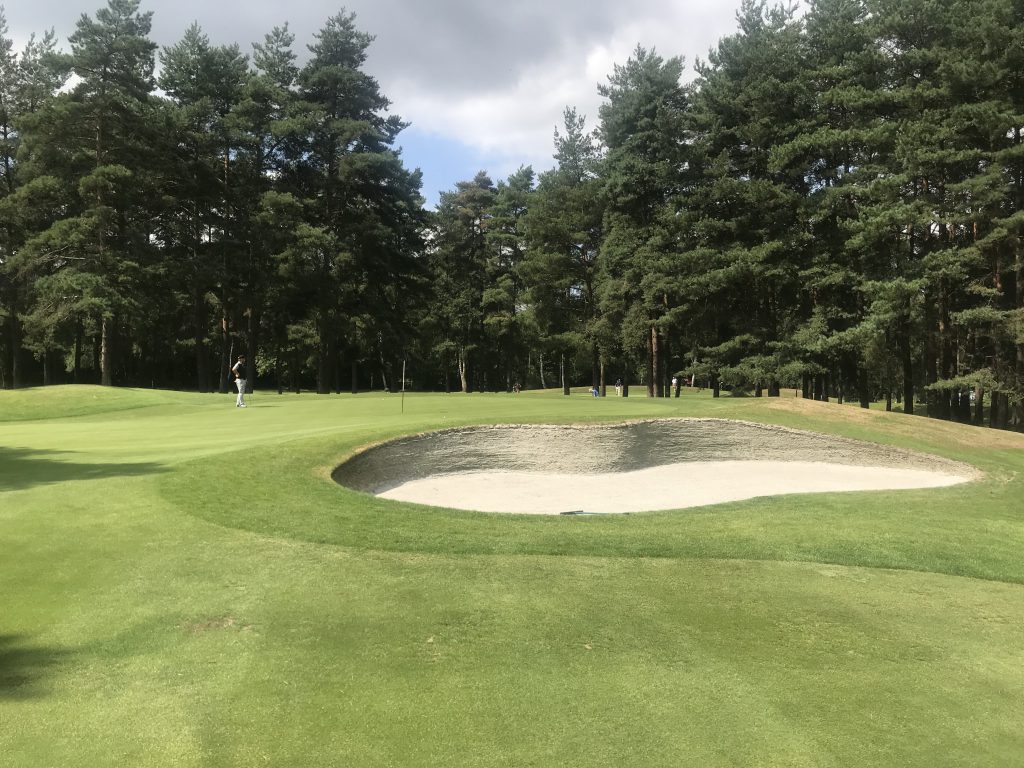
How do you communicate with the members?
I have a weekly newsletter that I send out to the members to keep them updated with the week’s work and any upcoming projects. I write a course report annual for the members’ AGM and must present this to them.
I also have a focus report I have to send to the directors once a week on course conditions, upcoming projects, targets, high spend items that will be coming up, weather conditions and data.
GreenKeeping: With your many years’ experience, what advice would you give to youngsters starting out and wanting to pursue a career in the profession?
Dan Harding: Always ask questions about what you are doing and why, get as much knowledge and information as you can, read as much literature as possible, get to seminars, try to travel abroad for international experience. There are great opportunities to volunteer at events which helps you to get to know other greenkeepers. Getting to know other greenkeepers is a huge advantage when you become a course manager. I have a few course managers locally who I will often phone for advice, recommendation, machines; it is sometimes just good to talk turf to others.
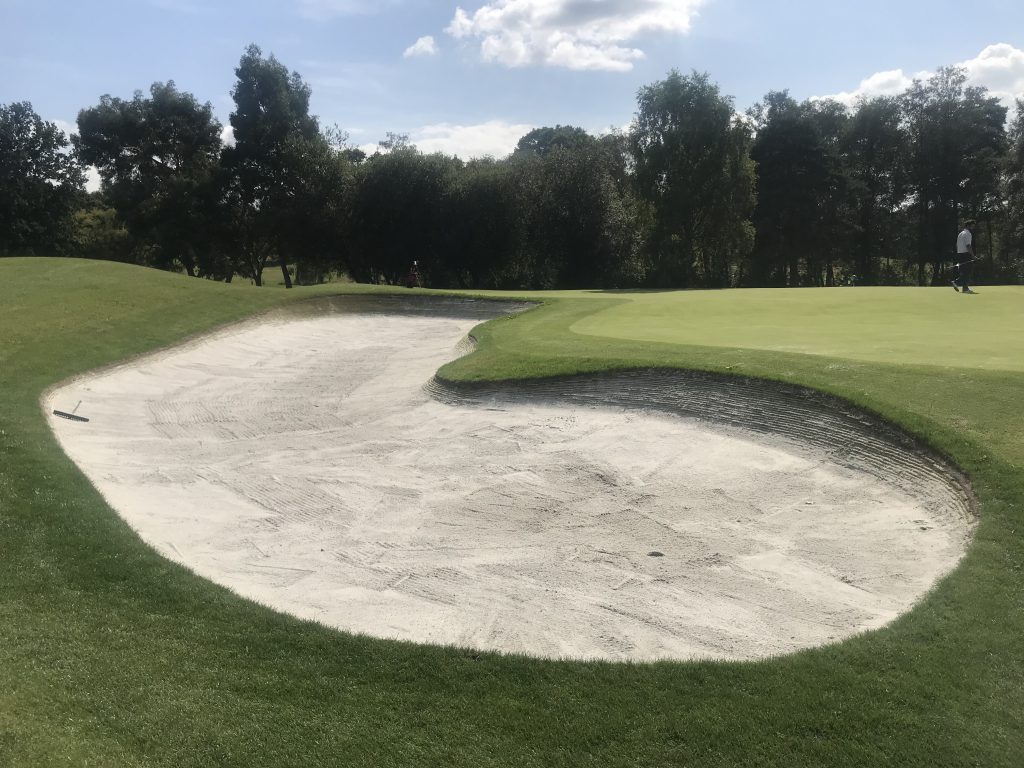
What changes do you think need to be made to benefit the industry sector and profession of the greenkeeper?
The industry is moving in the right direction, I think maybe we can keep pushing the education of young and experienced greenkeepers. BIGGA do a great job at BTME with this and are improving year to year.
I would like to see more respect shown from golfers, from simply raking bunkers and repairing pitch marks to letting the greenkeepers do the job they have trained and studied for a number of years for.

























